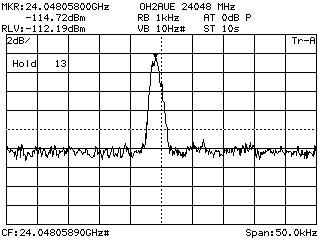

- successful testing of the K band transmitter in Orbit 396
- tests preseded by a lot of different frequency and pointing calibrations etc.
- one measure of system performance is ambient ground noise over cold sky (3k) (1.4 dB)
- and another is sun noise over cold sky, see this solar transit (3k) plot, sweep time 1000 s, noise 3.2 dB
- this was the test environment (80k) for this ad hoc test session
- signals first heard by G3WDG and G4KGC (MA=122) and then also by myself, OH2AUE (MA=125)
- here is a photo of the offset dish setup (17k) used by Charlie and Petra for copying the 24 GHz TX
- conditions at OH2AUE were suboptimal with overcast & rain drumming on the radome (52k)
- here is an overall view (73k) of my 24192/24048 transverter behind the 60 cm prime focus dish
- the block diagram of this transverter is here (12k). More on my K band project pages.
- and the block diagram of my second 24 GHz transverter is here (11k).
- this is what the 24048 MHz downlink (3k) looked like on 62 000 km with the Middle Beacon and traffic
- telemetry indicates normal output power and behavior as you can see in this raw data plot (3k)
- telemetry analysis with W4SM's wonderful P3T software
- wondering what the Middle Beacon sounds like at 24 GHz 62 000 km (18k) away ? Listen to this (133k) ;-)
- as the K band transmitter uses linear polarisation and my test setup was also linear, there is a lot of spin modulation (132k)
- here we have a station calling CQ on CW (100k)
- and for equalities sake a station on SSB too (433k)
- with LEILA also maintaing a uniform EIRP profile by zapping (67k) non-conformists ;-)
- photo (29k) of the linearly polarized feed on the 120 cm 24 GHz dish
- the dish is situated at 108 m ASL (44k) giving excellent visibility towards the satellite 62 000 km away
- copying telemetry on 2401 MHz was totally impossible due to the horrendous level of commercial RF on this band :-(
- started of the testing by checking my LO frequency (/8) again: only 5 kHz higher than nominal ;-)
- the additional difference is also a flexible WG section with 1.3 dB loss at 24048 MHz
- now the middle beacon (MA=126) was ~15 dB above (4k) the noise floor (WITHOUT sample detection for the noise !)
- after a while (MA=134) the temperature drift and Doppler have shifted (4k) the MB downwards in frequency
- here is an excerpt of DB6NT (141k) on the K band downlink (note spin amplitude modulation)
- and a longer recording of DB6NT working G3WDG (647k !) during orbit 406 on the K band downlink
- a recording of F6FKV (442k !) calling CQ on the K band downlink, orbit 406
- decoded (CRC errors) matrix status (9k) from 24 GHz downlink audio (recording, orbit 396)
- decoded (CRC errors) status screen (8k) from the K downlink audio (recording, orbit 396)
- and another (CRC errors) decoded status screen (13k) from K band audio
- the software used for demodulation/decoding is AO40RCV.EXE, version 1.31, CRC check disabled
- try for yourself ! Here (256k) one block of AO40RCV compatible audio from the 24 GHz beacon on orbit 406 ;-)